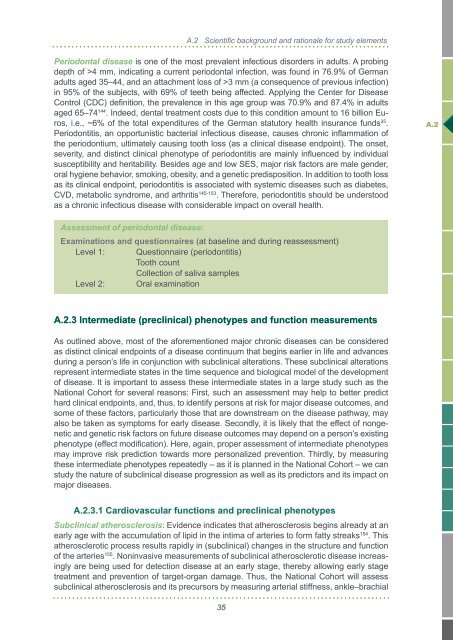Scientific Concept of the National Cohort (status ... - Nationale Kohorte
Scientific Concept of the National Cohort (status ... - Nationale Kohorte
Scientific Concept of the National Cohort (status ... - Nationale Kohorte
You also want an ePaper? Increase the reach of your titles
YUMPU automatically turns print PDFs into web optimized ePapers that Google loves.
A.2 <strong>Scientific</strong> background and rationale for study elements<br />
Periodontal disease is one <strong>of</strong> <strong>the</strong> most prevalent infectious disorders in adults. A probing<br />
depth <strong>of</strong> >4 mm, indicating a current periodontal infection, was found in 76.9% <strong>of</strong> German<br />
adults aged 35–44, and an attachment loss <strong>of</strong> >3 mm (a consequence <strong>of</strong> previous infection)<br />
in 95% <strong>of</strong> <strong>the</strong> subjects, with 69% <strong>of</strong> teeth being affected. Applying <strong>the</strong> Center for Disease<br />
Control (CDC) definition, <strong>the</strong> prevalence in this age group was 70.9% and 87.4% in adults<br />
aged 65–74 144 . Indeed, dental treatment costs due to this condition amount to 16 billion Euros,<br />
i.e., ~6% <strong>of</strong> <strong>the</strong> total expenditures <strong>of</strong> <strong>the</strong> German statutory health insurance funds 35 .<br />
Periodontitis, an opportunistic bacterial infectious disease, causes chronic inflammation <strong>of</strong><br />
<strong>the</strong> periodontium, ultimately causing tooth loss (as a clinical disease endpoint). The onset,<br />
severity, and distinct clinical phenotype <strong>of</strong> periodontitis are mainly influenced by individual<br />
susceptibility and heritability. Besides age and low SES, major risk factors are male gender,<br />
oral hygiene behavior, smoking, obesity, and a genetic predisposition. In addition to tooth loss<br />
as its clinical endpoint, periodontitis is associated with systemic diseases such as diabetes,<br />
CVD, metabolic syndrome, and arthritis 145-153 . Therefore, periodontitis should be understood<br />
as a chronic infectious disease with considerable impact on overall health.<br />
Assessment <strong>of</strong> periodontal disease:<br />
Examinations and questionnaires (at baseline and during reassessment)<br />
Level 1: Questionnaire (periodontitis)<br />
Tooth count<br />
Collection <strong>of</strong> saliva samples<br />
Level 2: Oral examination<br />
A.2.3 Intermediate (preclinical) phenotypes and function measurements<br />
As outlined above, most <strong>of</strong> <strong>the</strong> aforementioned major chronic diseases can be considered<br />
as distinct clinical endpoints <strong>of</strong> a disease continuum that begins earlier in life and advances<br />
during a person’s life in conjunction with subclinical alterations. These subclinical alterations<br />
represent intermediate states in <strong>the</strong> time sequence and biological model <strong>of</strong> <strong>the</strong> development<br />
<strong>of</strong> disease. It is important to assess <strong>the</strong>se intermediate states in a large study such as <strong>the</strong><br />
<strong>National</strong> <strong>Cohort</strong> for several reasons: First, such an assessment may help to better predict<br />
hard clinical endpoints, and, thus, to identify persons at risk for major disease outcomes, and<br />
some <strong>of</strong> <strong>the</strong>se factors, particularly those that are downstream on <strong>the</strong> disease pathway, may<br />
also be taken as symptoms for early disease. Secondly, it is likely that <strong>the</strong> effect <strong>of</strong> nongenetic<br />
and genetic risk factors on future disease outcomes may depend on a person’s existing<br />
phenotype (effect modification). Here, again, proper assessment <strong>of</strong> intermediate phenotypes<br />
may improve risk prediction towards more personalized prevention. Thirdly, by measuring<br />
<strong>the</strong>se intermediate phenotypes repeatedly – as it is planned in <strong>the</strong> <strong>National</strong> <strong>Cohort</strong> – we can<br />
study <strong>the</strong> nature <strong>of</strong> subclinical disease progression as well as its predictors and its impact on<br />
major diseases.<br />
A.2.3.1 Cardiovascular functions and preclinical phenotypes<br />
Subclinical a<strong>the</strong>rosclerosis: Evidence indicates that a<strong>the</strong>rosclerosis begins already at an<br />
early age with <strong>the</strong> accumulation <strong>of</strong> lipid in <strong>the</strong> intima <strong>of</strong> arteries to form fatty streaks 154 . This<br />
a<strong>the</strong>rosclerotic process results rapidly in (subclinical) changes in <strong>the</strong> structure and function<br />
<strong>of</strong> <strong>the</strong> arteries 155 . Noninvasive measurements <strong>of</strong> subclinical a<strong>the</strong>rosclerotic disease increasingly<br />
are being used for detection disease at an early stage, <strong>the</strong>reby allowing early stage<br />
treatment and prevention <strong>of</strong> target-organ damage. Thus, <strong>the</strong> <strong>National</strong> <strong>Cohort</strong> will assess<br />
subclinical a<strong>the</strong>rosclerosis and its precursors by measuring arterial stiffness, ankle–brachial<br />
35<br />
A.2



